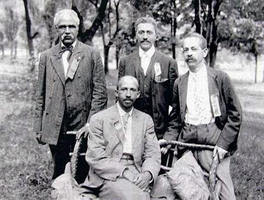 | Back to e-WV
| Back to e-WV
 The West Virginia Encyclopedia
The West Virginia Encyclopedia
 | Back to e-WV
| Back to e-WV
 The West Virginia Encyclopedia
The West Virginia Encyclopedia

The Niagara Movement, a short-lived but important activist organization founded by African-American intellectuals at Niagara Falls in 1905, had its first public meeting at Harpers Ferry the following year. Its origins lay in the growing differences between Booker T. Washington, then the most powerful Black leader in the United States, and an increasingly vocal group of more radical intellectuals. While Washington counseled accommodation with Whites and stressed economic advancement, his critics urged protest and demanded full civil rights.
When an attempt to bridge these differences in a conference in New York in January 1904 failed, Washington’s critics concluded that an organization dedicated to militant action was necessary. William Monroe Trotter, W.E.B. DuBois, and 27 other Black men met in Canada, near Niagara Falls, in July 1905, and formed the Niagara Movement. Niagarites adopted a Declaration of Principles denouncing unequal treatment in areas such as suffrage, education, and labor.
On August 15, 1906, the Niagara Movement began a five-day meeting at Storer College in Harpers Ferry. The meeting featured a daylong tribute to John Brown, which included a barefoot pilgrimage to Brown’s Fort and DuBois’s ‘‘Address to the Country.’’ DuBois claimed for Blacks ‘‘every single right that belongs to a freeborn American’’ and rededicated conferees to ‘‘the final emancipation of the race which John Brown died to make free.’’ The meeting’s sometimes strident rhetoric dismayed Storer College officials, who, believing the African-American school had been hurt, apparently responded coolly when Niagarites considered returning in 1907.
At the height of its success, the Niagara Movement reported about 400 members and chapters in 34 states, but the organization struggled from its inception. Washington’s opposition limited support, and organizational problems and internal feuding further weakened the movement. Annual meetings were held in Boston in 1907, Oberlin, Ohio, in 1908, and Sea Isle City, New Jersey, in 1909. The 1910 meeting never materialized, and the Niagara Movement finally dissolved in 1911 when DuBois suggested members join the recently formed, interracial National Association for the Advancement of Colored People.
Written by Mary Johnson
Lewis, David Levering. W.E.B. DuBois: Biography of a Race, 1868-1919. New York: Henry Holt & Co., 1993.
Quarles, Benjamin. Allies for Freedom: Blacks and John Brown. New York: Oxford University Press, 1974.
Address to the Country. W.E.B. DuBois: A Reader. New York: Henry Holt & Co., 1995.
Rudwick, Elliott M. The Niagara Movement. Journal of Negro History, July 1957.